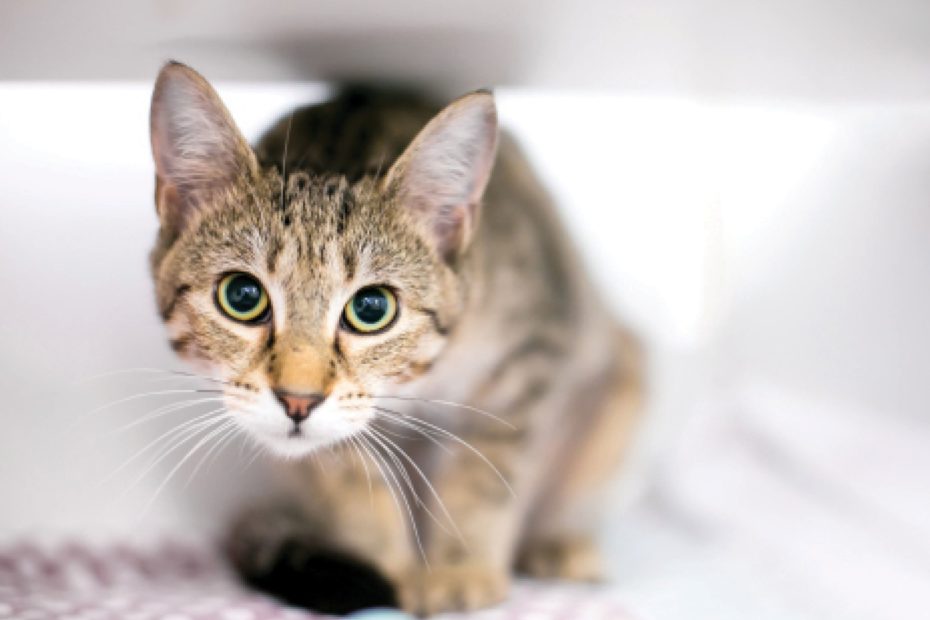A cat’s sense of stealth is strong: preventing their predators and prey from detecting them. The goal is to see without being seen. Cats prefer enclosed, high places where they can see who is coming and going, observing their world, feeling safe from their predators and undetected by prey.
This instinct is evidenced in the wild cat species, as well. Cougars and leopards blend in with their backgrounds so well that they go undetected by people living nearby. If you’ve hiked in cougar territory, you may not see a single cat, but that doesn’t mean they’re not spying on you. Unless they’re hunting for food or trying to impress a mate, most cats, including the wild species, generally don’t want a confrontation with other animals or people.
Even at home, unless they’re wearing a bell on their collar, we tend not to hear a cat approaching. How many times have we tripped over our cats because we didn’t know they were under our feet? In fact, bird advocates recommend attaching bells to outdoor cats’ collars to warn birds of their advances. Without that bell, cats have an advantage over their prey, which can’t hear them coming.
Cats’ sense of smell
We may appreciate an aromatic meal or a brewing pot of coffee, but our sense of smell is nothing like a cat’s. While our visual cortex is dominant in our brains, a cat’s olfactory cortex is dominant. That means cats rely on their sense of smell the way we rely on our eyesight. They identify everything and everyone through scent—and also hide their own scent from predators.
In fact, cats bury their waste, and queens immediately clean their newborn kittens for this very reason: They don’t want predators to find them.
A feline anomaly

A 2008 study from Duke University suggests that feline stealth is actually counterintuitive to evolution because it’s inefficient and requires large amounts of energy. In the study, Dogs Chase Efficiently, But Cats Skulk Counterintuitively, researchers wrote, “While the dogs depend on an energy-efficient style of four-footed running over long distances to catch their prey, cats seem to have evolved a profoundly inefficient gait, tailor-made to creep up on a mouse or bird in slow motion.”
In the study, Daniel Schmitt, a Duke associate professor of evolutionary anthropology, states that expending the least amount of energy for maximum efficiency is a principle of evolution. But to hunt successfully, cats must sneak up on their prey, and that requires prolific energy. However, although a cat’s gait is inefficient, it’s graceful.
“If they’re creeping, they’re going to put this foot down and then that foot down and then that one in an even fashion,” Daniel writes. Humans and dogs, on the other hand, rise and fall when they walk, which actually conserves energy.
This behavior matches other feline characteristics. Cats exude short bursts of explosive energy to hunt and stalk their prey. Making up for this inefficient energy use, cats sleep two-thirds of their lives to rejuvenate. They also need exercise and playtime that mimic the hunt in order to hone these innate stalking and pouncing abilities.
Traits of Feline Stealth
Here are just a few traits of our stealthy friends:
- Cats move quietly.
- Cats sneak up on prey.
- Cats observe their environment.
- Cats wait patiently for the right opportunity.
- Cats blend in with the foliage.
- Cats bury their waste to avoid being detected through scent.
- Cats hide when they’re sick or vulnerable.
- Cats do everything in such a way so that their prey and predators do not see, hear or smell them.
Dangers of Feline Stealth
Because enclosed, tight spaces are cat magnets, it’s important to check these areas before operating to prevent your cat getting injured:
- Car engines before starting ignition
- Your feet before walking
- Clothes dryers or any other appliance before turning them on
- Reclining furniture before closing
- Cabinets and closet doors before closing
